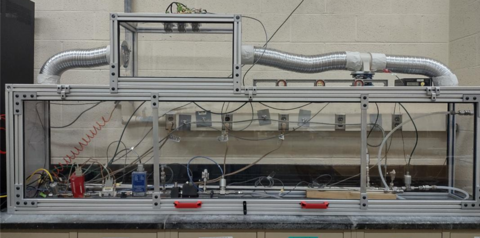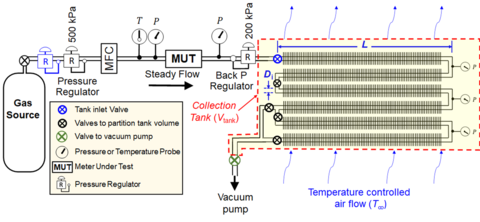Gas Flow Standard for Calibrating and Modeling Meters Used to Measure Semiconductor Process Gases - SlowFlowS

Figure 2. A prototype realization of Figure 1 with a collection volume that is 1/8th of the final volume to be used. The enclosure is temperature controlled at 25 °C.
Gas Flow Standard for Calibrating and Modeling Meters Used to Measure Semiconductor Process Gases - SlowFlowS
One of the most widely used instruments in semiconductor manufacturing is a mass flow controller (MFC), which is a flow meter that also controls the flow. As semiconductor manufacturing advances, the requirements on MFC performance are increasingly strict: any process variation can reduce device yield. In the year 2000, flow uncertainty of 1 % of full scale was acceptable, now 0.1 % of reading is desired. The industry requires interchangeability of MFCs: if an MFC fails, they need to replace it with a flow meter that provides the same flow behavior in order to successfully apply the same chip manufacturing recipe. Chip manufacturers require new process gases, lower flows, and better response times from MFCs to support new chip technologies.
Each model of MFC has gas correction factors. This is typically a simple multiplier to convert a calibration in nitrogen to another gas. For many gases, a simple multiplier is grossly inadequate to correct the performance of the flow meter. The MFC calibration curve is complex and poorly understood for many gases of interest (SF6, C4F8, NF3), partially because of a lack of primary flow standards that can safely handle toxic gases and a lack of low uncertainty gas property values. Experimentally validated physical models for the relevant flow meters coupled with accurate gas properties (e.g., viscosity, density, specific heat, thermal conductivity) will ultimately allow the chip industry to extrapolate a nitrogen calibration to the new, often toxic gases used to produce semiconductors.
NIST’s Fluid Metrology Group (FMG) has state of the art standards for realizing gas flow: the 34 L and 677 L pressure-volume-temperature-time (PVTt) systems. These primary standards measure mass flow from 0.1 sccm (standard cm3/min at 274.15 K and 101.325 kPa) to 2 × 106 sccm with expanded uncertainties ranging from 0.015 % to 0.025 % for N2, Ar, CO2, He, and air. A new flow standard that uses the rate-of-rise technique is being developed by the FMG to cover lower flow ranges and handle hazardous and corrosive gases. We call this standard the Semiconductor Low-Flow Standard, or SLowFlowS. The SLowFlowS will be used to calibrate MFCs in a variety of semiconductor process gases. The calibration data will be used to develop physical models that characterize how gas species affect flow. The physical models developed through these studies will generate gas correction functions to allow MFCs to be calibrated in inert gases like nitrogen, yet perform accurately in hazardous and corrosive gases typical of semiconductor manufacturing processes.

The primary components of SLowFlowS are shown in Figure 1 and include 1) the gas source; 2) a mass flow controller (MFC) to establish a constant mass flow; 3) the meter under test (MUT) being calibrated; 4) pressure regulators; 5) a long, slender collection tank of known volume; 6) a vacuum pump downstream of the collection tank; 7) pressure and temperature sensors; and 8) valves to start/stop flow and partition the collection tank or other parts of the standard; 9) a thermostatted enclosure (not shown in the figure) that recirculates air at constant temperature over the MUT piping and the collection tank. The SLowFlowS measures the increasing density of the gas in the collection tank with time to determine flow and hence, is called a rate-of-rise standard. Figure 2 shows a prototype realization of Figure 1 with a collection volume that is 1/8th of the final volume to be used. The enclosure is temperature controlled at 25 °C.

Specifications/Capabilities
- The FMG’s 34 L and 677 L pressure-volume-temperature-time (PVTt) standards have the best in the world capabilities in non-hazardous gases. They measure flow with uncertainty < 0.025 %. NIST research on the rate-of-rise gas flow measurement method extended capabilities down to 0.1 sccm, meeting the needs of the chip industry for ever smaller flows. The gas flow capabilities have been proven by numerous interlaboratory comparisons. These capabilities are the foundation for traceability and uncertainty for the tens of thousands of MFCs used in the chip fabrication industry.
- The FMG’s new SLowFlowS will lower the flow range capabilities to 0.01 sccm with a target expanded uncertainty of 0.1 % or less and allow for calibration of meters in hazardous semiconductor gases.
The FMG will develop physical models for the relevant flow meter types so that safe calibrations can be extrapolated to hazardous gases with low uncertainty. Note that this will require accurate physical properties (density, viscosity, heat capacity, and thermal conductivity) for the relevant gases. We are coordinating on property research with McLinden and Huber in the Thermophysical Properties of Fluids Group (please add this link for this group: https://www.nist.gov/mml/acmd/thermophysical-properties-fluids-group).
Scientific Opportunities/Applications
Low uncertainty flow measurements for the wide range conditions of temperature, pressure, flow, and gas species necessary for chip fabrication. Reproducible flow measurements are critical to high yields during multi-million dollar chip fabrication runs.
RELATED PROJECTS
- Flow Metering and Properties for Semiconductor Process Gases
- NIST Reference Fluid Thermodynamic and Transport Properties Database (REFPROP): Version 10
- Index of Semiconductor Process Gases

